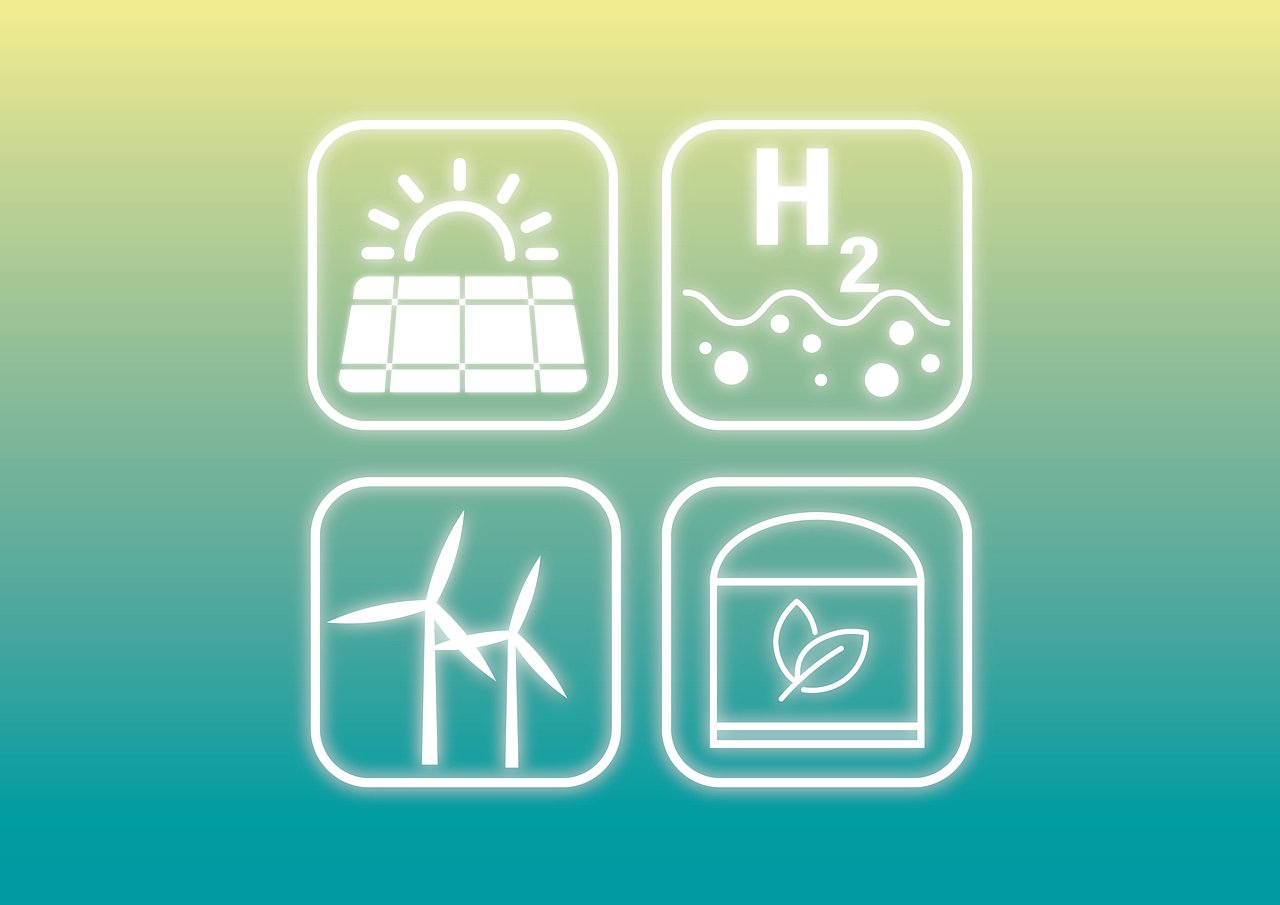Energy transition in Germany: What role for "Green Hydrogen"?

Share this Post
Authors: Michael Fehling and Larissa Bahmer
Introduction
In the quest for ‘climate neutrality,’ hydrogen gas (H2) has become a new hope for decarbonization in the European Union (EU) and for Germany, its largest economy with the highest carbon emissions. Hydrogen is expected to replace fossil resources in emission-intensive industrial processes (e.g., steelmaking, chemical manufacturing), as well as in the building (heating) and transport sector, though to a lesser extent and in a more distant future. As an energy source and a vehicle for energy storage, hydrogen is considered a pillar of the German “Energiewende” and the European “Green Deal.”
However, hopes on hydrogen face many practical hurdles. Hydrogen-based technologies are still under development, especially beyond the industry sector. Also, hydrogen transport infrastructures do not yet exist. The economic viability of hydrogen is doubtful, at least in the short term, due to the limited efficiency of hydrogen as an energy source and the costs of its production. Moreover, the climate impact of hydrogen is not necessarily positive, casting doubt on its potential to become a ‘silver bullet’ for climate neutrality. The carbon footprint of hydrogen depends on how it is produced, which has led to a lively discussion about different “colors” of hydrogen and their future in a climate-neutral economy.
Factual and Policy Background
Under the “Energiewende” leitmotif, Germany has seen considerable progress in the deployment of renewable energy over the past years, albeit the only significant leaps made were in the electricity sector (Umweltbundesamt). In fact, the overall potential of renewable power to build the backbone of the energy supply in Germany has until now appeared limited: The volatility of wind and solar power are exacerbated by lags in grid development and the absence of effective energy storage technologies.
Therefore, the overall political endorsement for green hydrogen in Germany is conspicuous against the background of the stagnant “Energiewende.” If used as energy storage, hydrogen may compensate for the volatility of wind and solar power, making the energy system more flexible and resilient to fluctuating supply and demand. Such flexibility is essential to ensure grid stability in an energy system that relies predominantly on green, renewable energy. Moreover, hydrogen as an energy carrier may replace fossil energy where direct electrification is not feasible. Such forms of hydrogen use are discussed under the dazzling terms of ‘power-to-x’[2] and “sector coupling”, i.e. efforts to combine the power-producing sector with the other sectors that consume energy. In the transport sector, green hydrogen promises decarbonization without systemic change or disruptions for final energy users. For instance, the weight and range of hydrogen-powered fuel cell electric vehicles in road and rail transport compares to that of vehicles with conventional combustion engines.
To date, hydrogen use is largely limited to the industry sector, and not for purposes of energy production. Moreover, the dominant means of hydrogen production is the method of ‘gray’ hydrogen, obtained by the steam reforming of natural gas. In Germany, the policy debate on the promotion of hydrogen beyond traditional industrial purposes largely focuses on green hydrogen, which refers to hydrogen obtained by electrolytic separation of water using electricity from renewable sources. Although few of the envisaged policies have been implemented yet, some current legislative developments – mainly in the field of energy law – are helpful in understanding how green hydrogen promotion is being addressed and what challenges lie ahead.
The euphoria surrounding green hydrogen has made waves across the policy-making sphere. It led to the adoption of a designated National Hydrogen Strategy (“Nationale Wasserstoffstrategie”) in June 2020 by the Federal Government then in charge, a ‘grand coalition’ composed of the Conservatives (CDU/CSU) on the one hand and the Social Democratic Party (SPD) on the other.[3]
The Strategy entails 38 proposed ‘measures’ that take into account the entire value chain from hydrogen production to its use. Although the long-term focus of Germany’s National Hydrogen Strategy is on green hydrogen, the other “colors” of hydrogen also come into play. In the mid-term perspective until 2030, the Strategy mainly envisages the import of green and “blue” hydrogen, which is obtained by natural gas reforming with the resulting CO2 being captured and stored via Carbon Capture and Storage (CCS) technologies. The Strategy emphasizes the import of hydrogen because the predicted demand for the hydrogen equivalent of 90 to 110 terawatt hours in 2030 falls short of an anticipated 14 terawatt hours of domestic green hydrogen production.[4]
In relation to governance, the Strategy foresees a cross-sectional approach for the further development and implementation of hydrogen policy. The main actors are the State Secretaries’ Committee for Hydrogen and the National Hydrogen Council (“Nationaler Wasserstoffrat”), an independent advisory board that is composed of 25 members affiliated with business and industry actors, research institutes as well as civil society organizations.[5] Indeed, the private sector has become an important and influential stakeholder and proponent in policy debates on hydrogen, given that the emphasis on hydrogen matches vested interests of businesses that face the challenge of decarbonization.
Green Hydrogen Promotion and the Law
Germany’s National Hydrogen Strategy strongly emphasizes the need to promote hydrogen, in particular green hydrogen production, and to accordingly adopt or amend the relevant legislation. Until now, there is no coherent legal framework for the integration of hydrogen in German energy law – only piecemeal legislation. Most of the few provisions in effect today deal with financial incentives, including through reducing financial burdens. Few provisions address the integration of hydrogen into the overall regulatory regime, which concentrates on energy networks. At the EU level, there is no consolidated legislative framework. However, EU law – in particular law on state aid and EU energy law – provides some impetus for the development of national promotion schemes for hydrogen, even beyond the field of energy law.
The viability of green hydrogen production is contingent on the availability of green electricity and its costs. Ambitions for green hydrogen “made in Germany” hence do not square with the fact that electricity prices are high and rising, which is also due to a growing share of state-induced price components such as taxes and levies. In fact, state-induced price components account for more than 50% of the electricity price. The most prominent example is the “EEG surcharge” for financing renewable energy support schemes. It is imposed on energy users regardless of whether the energy consumed is purchased or produced on-site according to the Renewable Energy Sources Act (EEG 2021).[6] Hence, businesses that operate their own power plants – a common phenomenon in the industry sector – cannot “escape” from the obligation to contribute to renewable energy promotion. The EEG surcharge applies to conventional and green energy equally and constitutes approximately one fifth of the purchase price for electricity.[7]
As part of the trend to promote domestic green hydrogen production, § 69b EEG 2021 provides for the non-applicability of the EEG surcharge for electricity consumed to produce green hydrogen. Its scope is limited to hydrogen production units put into operation before the year 2030, with the objective of making green hydrogen production more affordable and economically attractive while avoiding deterring effects in the short-term. A high-resolution, complex definition of the term “green hydrogen” was established by means of delegated legislation (§ 12i EEV), which determined that in order for hydrogen to be considered “green,” the electricity used for electrolysis must exclusively and traceably stem from renewable energy production units. Moreover, the production of the electricity must not have been subsidized already under the renewable energy promotion scheme of the EEG.[8]
However, there is a second option for hydrogen producers to be exempted from the EEG surcharge. Given that the surcharge is considered a competitive disadvantage for energy-intensive companies, a Special Equalization Scheme (“Besondere Ausgleichsregelung”) partially exempts them from the levy. A dedicated provision for hydrogen producers was added to the scheme with the latest major revision of the EEG. Pursuant to § 64a EEG 2021, companies (or parts thereof) whose main business activity is the production of hydrogen through electrolysis can request that the EEG surcharge be partially waived for their electricity consumption. As follows from § 63(1a) EEG 2021, the provision aims at furthering the technologies for hydrogen production and their deployment in Germany. Hence, it is applicable regardless of whether green electricity is used for the electrolysis. This accommodation is not open-ended, however, as § 93 EEG 2021 empowers the Federal Government to curtail the scope of applicability of § 64a EEG 2021 to green hydrogen production by means of delegated legislation in the future.[9]
Reductions of the EEG surcharge for specific companies or branches of a particular business are deemed state aid according to European Law and are therefore subject to obligatory notification to the European Commission (Art. 107, 108 Treaty on the Functioning of the European Union – TFEU). In 2021, the Commission approved a large portion of the provisions of the EEG 2021 that it considers compatible with the internal market. However, pivotal provisions for the promotion of hydrogen under the EEG 2021 have not yet been assessed. Most importantly, the Commission could not yet decide on § 69b EEG 2021 because the prerequisites for hydrogen being classified as green were established just recently. In accordance with European Law, § 69b EEG 2021 cannot be applied until it is approved by the Commission (Art. 108 (3) TFEU). Also, § 64a EEG 2021 is subject to further scrutiny by the Commission since it allows for a reduction of the EEG surcharge for hydrogen production in non-independent parts of companies, thereby incurring the danger of cross-subsidization.
In addition to the above legislative supports for the promotion of hydrogen, § 118 (6) Energy Industry Act (EnWG) seeks to promote the dissemination of hydrogen as a medium for energy storage, but also as an energy carrier and/or industry resource by waiving network charges both for electricity consumption in stationary electrolytic “power-to-gas” storage units and for feeding-in hydrogen gas to the natural gas grid. The latter is a viable option under the current legal framework because the prevailing view in the literature on § 118 (6) EnWG is that the exemption for hydrogen gas applies regardless of its further use. Unlike the narrow understanding of the term “energy storage,” no re-conversion is necessary.[10] § 118 (6) EnWG applies to hydrogen production by electrolysis, regardless of whether green electricity is used. However, since § 118 (6) EnWG is a transitional provision, this exemption is a short-term measure to promote hydrogen. It is unclear whether its scope of application will be expanded – and if so, by how much time.
Beside price alleviations, green hydrogen can be promoted by means of infrastructure, namely, by creating hydrogen-only grids. So far, green hydrogen fed into the natural gas grid enjoys some statutory privileges because it constitutes ‘biogas’ according to § 3 n. 10f EnWG,[11] However, the potential of such feed-in is limited for technical reasons.[12] It is therefore widely accepted that the prospective role of green hydrogen for the “Energiewende” will require hydrogen-only grids. Just recently, a subsection on the regulation of hydrogen-only grids was added in §§ 28j to 28q EnWG. The regulatory approach resembles the regulation of natural gas grids, but it is less strict. Unlike electricity and natural gas grids, hydrogen grids are not subject to mandatory regulation. An opt-in approach was chosen which leaves the decision as to whether the provisions shall apply to the network operators. Moreover, provisions were introduced that facilitate the conversion of natural gas grids into hydrogen-only grids, inter alia by streamlining the approval procedure (§ 43l EnWG).[13]
In relation to promoting and steering the use of green hydrogen in sector coupling, legislative activity is less conspicuous. One salient example, however, is in public vehicle purchases, where, clean vehicle quotas apply by virtue of the EU Clean Vehicles Directive (Directive (EU) 2019/1161) and its transposition into national law. The quotas can be fulfilled by purchasing vehicles that use alternative fuels, such as hydrogen. Again, green production of the fuels used is not mandated.
Last but not least, there are large-scale financial support and subsidization schemes outside of traditional energy law covering the entire hydrogen value chain.[14] For example, regarding financial support for businesses, in general, they are subject to legal boundaries such as the EU’s revised ‘Renewable Energy Directive (Directive (EU) 2018/2001, ‘RED II’) and EU state aid law. According to Art. 4 RED II, renewable energy promotion must be granted in an open, transparent, competitive, non-discriminatory, and cost-effective manner, which translates into a focus on tendering procedures by which subsidies are allocated. The impact of the prohibition of state aid according to Article 107 TFEU is softened by the General Block Exemption Regulation (Regulation (EU) 651/2014) and by the possibility to obtain the Commission’s approval according to the guidelines on state aid for climate, environmental protection and energy. Moreover, subsidies for hydrogen technologies may be accepted by the Commission as Important Projects of Common European Interests (IPCEIs) and approved according to the respective guidelines (2014/C 188/02).[15] In effect, EU law overall leaves considerable leeway for the promotion of the production and use of green hydrogen.[16]
Assessment
Given that the National Hydrogen Strategy and its implementation are still in the initial phase, any assessment is necessarily preliminary and incomplete. However, with a view to current efforts, some likely merits and shortcomings become visible.
The fact that a preference for green hydrogen is expressed in the Strategy and repeatedly reinforced in political declarations is laudable from a climate protection perspective. However, the state of current legislation that seeks to promote the deployment of hydrogen technologies in Germany hardly matches that preference. The partial exemption of hydrogen producers from the EEG surcharge in § 64a EEG 2021 is motivated predominantly by the concern of safeguarding the competitiveness of German energy-intensive industries in international markets. Unless the scope of the provision is limited to the production of green hydrogen, its impact on climate and environmental protection will be undermined. The provision promotes the deployment of electrolytic hydrogen production in general, rather than promoting the production of green hydrogen. The exemption in § 69b EEG 2021, which is applicable only to the production of green hydrogen, fits in better with the long-term goals in the National Hydrogen Strategy and, ultimately, Germany’s proclaimed climate ambition. However, since many important hydrogen producers can choose which of the two provisions to invoke, there is a concern that they will avoid the obligations to prove the green sources of the electricity used under § 69b EEG 2021 and instead opt for § 64a EEG 2021 with conventionally produced power, thus using natural gas or even coal.[17] In general, it is questionable whether the exemption of green hydrogen production from state-induced price components, which so far is the dominant strategy, will suffice for green hydrogen “made in Germany” to become economically viable.
Moreover, the emphasis on green hydrogen in the policy debate cannot compensate for the fact that Germany’s ambitions for the deployment of green hydrogen production capacities indeed are – at best – modest, especially compared to the expected demand for hydrogen in 2030 and beyond. Hence, large-scale hydrogen import will be necessary for meeting domestic demands and therefore create heavy import dependence. Many issues of hydrogen import are so far unresolved, including standards for blue hydrogen, which requires effective carbon capture and storage (CCS) technologies to be “climate neutral.” Furthermore, climate-friendly, yet economically feasible ways to transport hydrogen produced abroad still have to be established, as well as measures to safeguard the sustainability of hydrogen production, especially in the Global South, and to limit import dependency of specific countries.
With a view to hydrogen infrastructure deployment in Germany, most importantly in the form of hydrogen-only grids, it is yet to be seen how the most recent legislative developments and the choice of an opt-in procedure rather than a mandatory regulatory regime will play out, also with a view to anticipated EU lawmaking activity in the field of hydrogen grid regulation.
Lastly, it is regrettable that current lawmaking efforts do not address distributional issues that will most likely arise across different hydrogen uses, given that hydrogen – especially green hydrogen – will be a scarce resource in the foreseeable future. The National Hydrogen Strategy points to “priority areas,” but it does not foresee concrete instruments to establish an allocation-based on priority.
Outlook
It remains to be seen whether the ambitions of the National Hydrogen Strategy and the resulting implementation challenges will be reconciled under the aegis of the new Federal Government, which for the first time constituted by the Social Democratic Party (SPD), the Greens (GRÜNE) and the liberal Free Democratic Party (FDP). The new government is expected to make additional funding available for hydrogen projects, such as initial attempts at the offshore production of hydrogen.[18] A landmark project of the new government might be the realization of so-called Carbon Contracts for Difference (CCfD) in order to promote green hydrogen-based technologies in energy-intensive industries (e.g. in steelmaking), since this instrument is envisaged in the National Hydrogen Strategy (measure 15) and in the government’s coalition agreement (though both are of merely political nature and have no legal force). Also, the new Government plans to abolish the EEG surcharge already by July 1, 2022, meaning that the provisions to promote hydrogen production in the EEG 2021 could soon be obsolete, possibly without ever having been applicable. However, nothing substantial has yet been decided on by the national legislator, leaving the future of green hydrogen promotion in Germany opaque. Also, the proclaimed ambitions of the new Government do certainly matter, but any concrete measure must be closely linked to the development of EU legislation and the proposed “Fit for 55” package; it is by no means clear on which concrete legislative measures the Member States will be able to agree in the end. Whether hydrogen will live up to the expectations raised in the context of the “Energiewende” continues to critically hinge on successful implementation of policy strategies.
Further readings
[1] All internet sources in this Spotlight were last accessed on April 5, 2022.
[2] On ‘power-to-gas’ and hydrogen, see Schiebahn et al., “Power to Gas: Technological Overview, Systems Analysis and Economic Assessment for a Case Study in Germany,” International Journal of Hydrogen Energy vol. 40 (2015), pp. 4285-4294. Another example of ‘power-to-x’ technologies is the production of ‘e-fuels’ or ‘synthetic fuels’ from water and CO2 using large amounts of electricity. These fuels could power conventional heating units, heavy transport vehicles or airplanes with combustion engines.
[3] For a factsheet in English, see https://www.cleanenergywire.org/factsheets/germanys-national-hydrogen-strategy.
[4] See the National Hydrogen Strategy, p. 5.
[5] See the National Hydrogen Strategy, pp. 15, 16.
[6] The Erneuerbare-Energien-Gesetz (EEG) was originally adopted in 2000 but has since undergone several complete revisions.
[7] For more information on electricity price components in Germany, see https://www.cleanenergywire.org/factsheets/what-german-households-pay-power.
[8] As Große/Lehnert, “Power-to-Gas: Die Regelungen des EEG 2021 zur Wasserstoffherstellung,” EnWZ 2021, 55, 64, point out, this requirement was probably introduced to ensure compliance with EU state aid law.
[9] See Große/Lehnert, EnWZ 2021, 55 et seq. for a thorough assessment of the provision.
[10] Kment, Energiewirtschaftsgesetz, EnWG, 2nd ed., § 118 recital 17, 18.
[11] The requirements of § 3 n. 10f EnWG are lower than those for green hydrogen according to § 12i EEV.
[12] See “Grenzwerte für Wasserstoff (H2) in der Erdgasinfrastruktur,” an analysis by Research Services of the German Federal Parliament (Bundestag), https://www.bundestag.de/resource/blob/646488/a89bbd41acf3b90f8a5fbfbcb8616df4/WD-8-066-19-pdf-data.pdf.
[13] For a detailed analysis of the new provisions, see Stelter/Schieferdecker/Lange, “Der Gesetzentwurf zur Regelung reiner Wasserstoffnetze im EnWG,” EnWZ 2021, 99 et seq.
[14] Recently, the Federal Government has made available around nine billion euros of funding for different hydrogen projects, including for international collaborations. See https://www.dw.com/en/germany-and-hydrogen-9-billion-to-spend-as-strategy-is-revealed/a-53719746.
[15] Together with 21 other EU Member States and Norway, Germany signed a “Manifesto for the Development of a European “Hydrogen Technologies and Systems Value Chain” and aims at realizing IPCEIs on hydrogen. See https://www.bmwi.de/Redaktion/DE/Downloads/M-O/manifesto-for-development-of-european-hydrogen-technologies-systems-value-chain.pdf?__blob=publicationFile&v=10 and https://www.bmwi.de/Redaktion/DE/Artikel/Energie/ipcei-wasserstoff.html.
[16] See Burgi/Zimmermann, “Der (künftige) EU-beihilferechtliche Rahmen für die Förderung von grünem Wasserstoff,” ZUR 2021, 212 et seq. for a detailed assessment.
[17] By means of legislation, it was decided in 2020 that coal-fired power generation in Germany will cease by 2038 at latest. For more information, see https://www.bmu.de/en/topics/climate-adaptation/climate-protection/national-climate-policy/translate-to-english-fragen-und-antworten-zum-kohleausstieg-in-deutschland.
[18] The allocation of dedicated areas is projected in a tendering procedure with the first call in 2022; applications for funding can be made by successful tenderers at a later stage. See https://www.bmwi.de/Redaktion/DE/Pressemitteilungen/2021/09/20210924-bundeswirtschaftsministerium-treibt-wasserstoff-auf-see-voran-verordnung-zur-vergabe-von-flachen-fur-die-wasserstofferzeugung-auf-see-veroffentlicht.html.
The opinions expressed in this text are solely that of the author/s and do not necessarily reflect the views of IPPI and/or its partners.
Share this Post

What is Gendered Disinformation?
Introduction. Why is it important to talk about gendered disinformation? One can say that fake news is old…

The Global Story of Election Interference
Authors: Olaf Boehnke and Carlo Zensus Ever since citizens have been communicating online with each other via emails,…

What is sustainable finance?
“Sustainable” finance aims to leverage financial actors and resources to support sustainable and climate-friendly economic activities and projects.…
